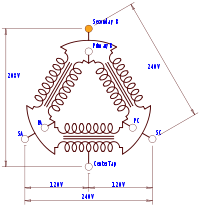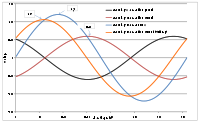
High leg delta
Encyclopedia
High-leg delta is a type of electrical service connection often found in older three-phase electric power
installations. Predating today's 480/277 V or 208/120 V three-phase systems, it was used where both lighting and three-phase motor loads were fed from the same distribution system.



Because the winding between the 'A' and 'C' phases is center-tapped, the line-to-neutral voltages for these phases are as follows:

But the phase-neutral voltage for the 'B' phase is different:

This can be proven by writing a KVL equation starting from the grounded neutral:

Note: Writing the KVL equation going the other way, the same magnitude is found, though the phase angle will of course be different.
Where the three-phase load is small relative to the total load, two individual transformers may be used instead of the three for a "full delta" or a three-phase transformer, thus providing a variety of voltages at reduced cost. This is called "open-delta high-leg", and has a reduced capacity relative to a full delta.
(for large motors).
However, many jurisdictions forbid more than one class for a premises' service, and the choice may come down to 120/240 single-/three-phase (delta), 120/208 three-phase (wye), or 277/480 three-phase (wye).
The advantages for 120/208 single/three-phase and 120/208 three-phase is all wiring methods and materials are "300 volt class".
The advantage for 277/480 three-phase is 277 single-phase wiring methods and materials are "300 volt class". However, 480 three-phase wiring methods and materials are "600 volt class".
600 three-phase is less common in the U.S. now, but the earlier incarnations of it, 550 and 575 three-phase remains popular in Canada.
Three-phase electric power
Three-phase electric power is a common method of alternating-current electric power generation, transmission, and distribution. It is a type of polyphase system and is the most common method used by grids worldwide to transfer power. It is also used to power large motors and other heavy loads...
installations. Predating today's 480/277 V or 208/120 V three-phase systems, it was used where both lighting and three-phase motor loads were fed from the same distribution system.


Supply
This type of service is supplied in one of two ways. One is by a transformer having four wires coming out of the secondary, the three phases, plus a neutral connected as a center-tap on one of the windings. Another commonly used method requires two transformers. One transformer is connected to one phase of the overhead primary distribution circuit to provide the 'lighting' side of the circuit (this will be the larger of the two transformers), and a second transformer is connected to another phase on the circuit and its secondary is connected to one side of the 'lighting' transformer secondary, and the other side of this transformer is brought out as the 'high leg'. The voltages between the three phases are the same in magnitude, however the voltage magnitudes between a particular phase and the neutral vary. The phase-to-neutral voltage of two of the phases will be half of the phase-to-phase voltage. The remaining phase-to-neutral voltage will be √3 times half the phase-to-phase voltage. Typically, the transformer is connected such that the 'B' phase is the 'high' leg. According to Article 110.15 of the 2005 National Electrical Code, panelboards connected to this type of transformer must explicitly identify the high leg, preferably by coloring it orange.Comparison
This is basically a delta system with a "mid-point" level added. Alternatives are symmetrical delta where the three phases have the same voltage to ground, and corner-grounded delta. Where the system is grounded has little effect on basic operation. It can be considered a two-phase system, since relative to ground, the "high" phase is 90 degrees from the other two. The voltage is such that phase-to-phase voltages are 60 and 120 degrees apart, thus compatible with three-phase equipment.Example
Consider the low voltage side of a 120/240 V high leg delta connected transformer, where the 'B' phase is the 'high' leg. The line-to-line voltages are all the same:
Because the winding between the 'A' and 'C' phases is center-tapped, the line-to-neutral voltages for these phases are as follows:

But the phase-neutral voltage for the 'B' phase is different:

This can be proven by writing a KVL equation starting from the grounded neutral:

Note: Writing the KVL equation going the other way, the same magnitude is found, though the phase angle will of course be different.
Advantages
This type of service is usually supplied using 240 V line-to-line and 120 V line-to-neutral. In some ways, the high leg delta service provides the best of both worlds: a line-to-line voltage that is higher than the usual 208 V that most three-phase services have, and a line-to-neutral voltage (on two of the phases) sufficient for connecting appliances and lighting. Thus, large pieces of equipment will draw less current than with 208 V, requiring smaller wire and breaker sizes. Lights and appliances requiring 120 V can be connected to phases 'A' and 'C' without requiring an additional step-down transformer.Where the three-phase load is small relative to the total load, two individual transformers may be used instead of the three for a "full delta" or a three-phase transformer, thus providing a variety of voltages at reduced cost. This is called "open-delta high-leg", and has a reduced capacity relative to a full delta.
Disadvantages
Since one phase-to-neutral voltage (phase 'B') is higher than the others, no single phase loads can be connected to this phase. This eliminates the ability to use one third of the breakers in a panel for single-phase loads. Further, the lack of loading on the high leg will result in an unbalanced load. An autotransformer may be used to convert the 208 V to 120 V.Usage
High-leg delta is commonly found in older systems. Current practice is to give separate services for single-phase and three-phase loads, e.g., 120 V split-phase (lighting et cetera) and 240 V to 600 V three-phaseThree-phase electric power
Three-phase electric power is a common method of alternating-current electric power generation, transmission, and distribution. It is a type of polyphase system and is the most common method used by grids worldwide to transfer power. It is also used to power large motors and other heavy loads...
(for large motors).
However, many jurisdictions forbid more than one class for a premises' service, and the choice may come down to 120/240 single-/three-phase (delta), 120/208 three-phase (wye), or 277/480 three-phase (wye).
The advantages for 120/208 single/three-phase and 120/208 three-phase is all wiring methods and materials are "300 volt class".
The advantage for 277/480 three-phase is 277 single-phase wiring methods and materials are "300 volt class". However, 480 three-phase wiring methods and materials are "600 volt class".
600 three-phase is less common in the U.S. now, but the earlier incarnations of it, 550 and 575 three-phase remains popular in Canada.

